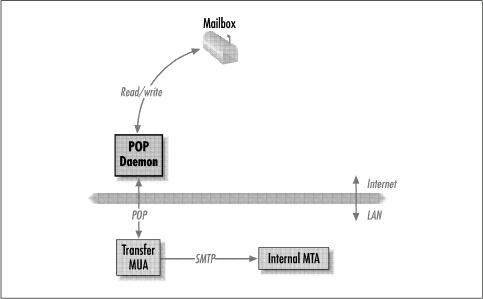Receiving Mail by MUAs
Once mail is available in a mailbox and that mailbox is accessible either locally or via an MRA, the messages may be displayed, filed, and responded to. The program that does this is a mail user agent. Most MUAs are meant for direct human interaction, however many automatic processes also deal with mail. MUAs may be either interactive MUAs, transfer MUAs, or special purpose MUAs.
Interactive MUAs are client programs with a user interface, meant for interactive use by human beings. This is how most of us get our mail. Interactive MUAs can be complex, encompassing as much functionality as possible to make the user’s interaction simple and powerful.
An interactive MUA should provide a user interface for manipulating all aspects of Internet email, possibly including the ability to:
Send standards-compliant mail directly to a receiving MTA or via a forwarding MTA.
Attach arbitrary files to outgoing messages.
Retrieve mail from a user’s mailbox, either directly or via an MRA.
Display the contents of a user’s mailbox.
File messages into multiple folders for storage.
Delete messages from the folders or mailbox.
Reply to or forward received messages.
Display the status of received messages (e.g., new, replied to, forwarded, etc.).
Provide an address book of commonly used email addresses and a way to enter new addresses into the book, possibly from incoming messages.
Display as many MIME document types as possible, either natively or via helper applications. This helps the user quickly understand and react to the content of attachments received in mail messages.
Set and modify mail server preferences, such as the SMTP server to use for outgoing mail and the type and location of the MRA or mailbox to use for incoming mail.
Change the display preferences for the user interface.
View the message in various ways, such as by a nicely formatted interface with the headers separated and in “raw” form.
Save the message or its individual parts to a filesystem.
Search the contents of the folders containing saved messages.
Automatically filter messages into folders on delivery based on user-defined rules.
Provide a help facility.
Some MUAs also provide the ability to interact with the Network News Transfer Protocol (NNTP) to read, sort, and file Usenet news articles. This is done simply because the functionality required of mail and news readers overlap tremendously.
Some programs or scripts emulate an MUA in order to retrieve messages and then remail them to another location. We will call such programs transfer MUAs. Unix’s fetchmail, for example, retrieves messages from a POP server and remails them to a local account via SMTP. It is useful for intermittently connected LANs. A utility that copies the contents of a POP mailbox to another mail account is a transfer MUA.
Figure 1-5 shows an example of a transfer MUA in action.
Some programs do not transfer messages from a mailbox for consumption else where, but nevertheless send messages or act on mailboxes as if they were MUAs. We call those programs or scripts special purpose MUAs. An application that checks a mailbox periodically and notifies a user when new mail arrives is an example of a special purpose MUA.
In Chapter 15, we develop a special purpose MUA that sends MIME-compliant email messages from a command line.

